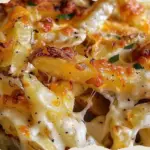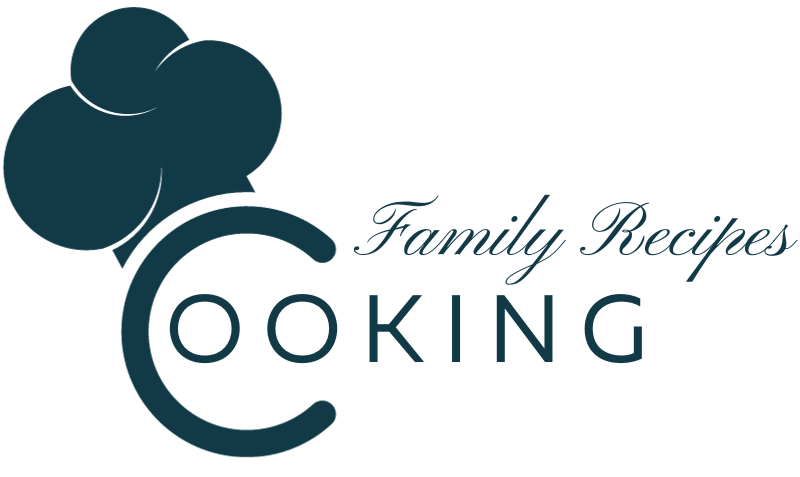The humble potato has long been a staple in kitchens worldwide, but when transformed into Creamy Cheesy Potatoes, it becomes a dish of pure indulgence. This comforting side dish, with its rich, velvety texture and golden, cheesy crust, has won the hearts of many. It’s not just a dish; it’s a celebration of simplicity and flavor that brings comfort to any meal. Whether served alongside a succulent roast chicken or as part of a festive holiday spread, Creamy Cheesy Potatoes stand out for their delicious adaptability.
Originating from the need for hearty and satisfying meals, this dish combines the earthy goodness of potatoes with the melting richness of cheese. Using ingredients like russet potatoes and cheddar cheese, each bite offers a taste of homey comfort. The dish’s simplicity belies its complex flavors, which can be attributed to the perfect blend of seasoning and dairy. The preparation involves layering thinly sliced potatoes with a generous amount of cheese and cream, baking until the potatoes are tender and the top is irresistibly golden and bubbly.
Creamy Cheesy Potatoes have evolved beyond their basic recipe to include variations that cater to every taste and occasion. From adding bacon for a smoky depth to incorporating green onions for a fresh pop of flavor, the possibilities are endless. This versatility ensures that Creamy Cheesy Potatoes remain a beloved classic in the culinary world, embodying the essence of comfort food. As we dive deeper into the nuances of this dish, let’s explore its origins, key ingredients, and the secrets to perfecting it at home.
The History of Creamy Cheesy Potatoes :
The roots of Creamy Cheesy Potatoes can be traced back to the American Midwest, where comfort food reigns supreme. This dish, also affectionately known as “funeral potatoes” in some communities, has a rich history of bringing people together in both celebration and solace. It embodies the spirit of communal dining and has been a fixture at potlucks, church gatherings, and family dinners for generations. The exact origins are difficult to pinpoint, as variations of cheesy potato dishes exist in many cultures due to the universal appeal of its primary ingredients.
Potatoes, introduced to Europe from the Americas in the 16th century, quickly became a staple food crop. As they spread across the world, different cultures adopted them into their cuisines. The combination of potatoes with cheese and cream, however, holds a special place in American culinary tradition. It’s a testament to the ingenuity of home cooks who created satisfying dishes with available ingredients, ensuring nothing went to waste. These early versions of Creamy Cheesy Potatoes often included canned soup for convenience, a practice that remains popular today.
The evolution of this dish reflects broader trends in American cooking, moving from simple, hearty fare to include more sophisticated and varied ingredients. Modern takes on the recipe often feature a homemade cream of chicken soup to reduce sodium intake or incorporate gourmet cheeses like Gruyère for a more complex flavor profile. This adaptability has helped Creamy Cheesy Potatoes remain a favorite across the United States.
Despite its humble beginnings, the dish has gained a following far beyond the Midwest. From holiday tables to casual weeknight dinners, Creamy Cheesy Potatoes continue to comfort and delight with their creamy texture and cheesy goodness. This dish’s history is not just about food but about the stories and memories shared over countless servings of this beloved comfort food.
Essential Ingredients for Creamy Cheesy Potatoes :
To achieve the perfect Creamy Cheesy Potatoes, understanding and selecting the right ingredients is key. Each component plays a crucial role in creating the dish’s signature texture and flavor. Here’s a detailed breakdown of the essential ingredients:
- Potatoes: The foundation of the dish. Russet potatoes are the preferred choice for their starchy texture, which contributes to the creaminess. These potatoes absorb the sauce beautifully without falling apart. For more on the types of potatoes and their uses, visit different types of potatoes.
- Cream: Heavy whipping cream adds richness and moisture, enveloping the potatoes in a silky sauce as they bake. It’s the secret to achieving that decadent mouthfeel.
- Cheese: A blend of cheddar cheese and parmesan cheese provides a sharp, tangy taste that balances the dish’s richness. Cheddar offers meltiness and flavor, while parmesan imparts a salty, nutty edge. For more on cheese in cooking, see how cheese is used in cooking.
- Seasonings: Garlic powder, onion powder, salt, and pepper are simple yet effective in enhancing the natural flavors of the potatoes and cheese. They add depth and complexity to the dish.
- Butter: Incorporating melted butter into the sauce or dotting it on top before baking adds another layer of flavor and helps achieve a golden, crispy top.
Optional enhancements can include:
- Green Onions or Chives: For a fresh, mild onion flavor that cuts through the richness.
- Bacon or Ham: Cooked and crumbled bacon or diced ham can add a smoky, savory element to the dish.
- Sour Cream: Some recipes call for sour cream for added tanginess and creaminess.
When preparing Creamy Cheesy Potatoes, the quality of ingredients matters. Grating your own cheese, for example, ensures a smoother melt and a fresher taste than pre-shredded varieties. Similarly, opting for fresh, high-quality potatoes can make a significant difference in the texture and overall outcome of the dish.
For those interested in exploring variations, incorporating comfort food ideas like adding different cheeses or vegetables can personalize the dish to suit your taste. Remember, the beauty of Creamy Cheesy Potatoes lies in its simplicity and adaptability, making it a versatile dish that’s open to interpretation and innovation.
Step-by-Step Cooking Guide :
Creating the perfect batch of Creamy Cheesy Potatoes involves a few essential steps. Here’s a concise guide to ensure your dish turns out delicious every time.
- Prep the Potatoes: Begin by peeling your russet potatoes. Slice them into thin pieces, about 1/8 inch thick, to ensure they cook evenly. Soaking the sliced potatoes in cold water can remove excess starch, which helps in achieving a creamier texture.
- Layering: In a greased 9×13 inch baking dish, arrange a layer of potato slices. Season each layer with salt, pepper, garlic powder, and onion powder for an even distribution of flavors.
- Cheese Sauce: In a separate bowl, mix heavy whipping cream with melted butter, a dash of garlic and onion powder, and half of your grated cheddar and parmesan cheese. This mixture should be poured evenly over the layered potatoes, ensuring each slice is coated.
- Baking: Cover the dish with foil and bake in a preheated oven at 350°F for about 60 minutes. Removing the foil in the last 20 minutes allows the top to become golden and crispy.
- Final Touch: Sprinkle the remaining cheese over the top and return to the oven until the cheese is melted and bubbly. Let the dish rest for a few minutes before serving to allow the sauce to thicken slightly.
For those eager to add a twist to the traditional recipe, consider incorporating ingredients such as crispy bacon, diced green onions, or even a sprinkle of paprika for a smoky flavor. The versatility of Creamy Cheesy Potatoes means you can adjust the recipe to suit your preferences while still maintaining its comforting essence.
Cooking is as much about creativity as it is about following recipes. For more culinary inspiration, check out potato dish presentation ideas to elevate the visual appeal of your creamy, cheesy creation.
FAQs :
Can I use other types of potatoes besides russet?
Yes, while russet potatoes are preferred for their texture and flavor absorption, you can also use Yukon Gold for a creamier texture. Each variety brings a unique characteristic to the dish.
Is it possible to make Creamy Cheesy Potatoes ahead of time?
Absolutely. Assemble the dish up to a day in advance and refrigerate. When ready to serve, bake as directed, adding extra time if starting from cold.
Can I add extra ingredients to the dish?
Definitely. Feel free to customize with additions like crumbled bacon, diced ham, green onions, or even different cheeses like Gruyère or smoked gouda for a unique twist.
How do I store leftovers, and how long will they last?
Leftovers can be stored in an airtight container in the refrigerator for up to 3-5 days. Reheat in the oven or microwave until thoroughly warmed.
Can Creamy Cheesy Potatoes be frozen?
It’s not recommended to freeze this dish due to the dairy components, which may separate and affect the texture upon thawing. For best results, enjoy fresh or store in the refrigerator.
Print
CREAMY CHEESY POTATOES
- Author: Easy Recipes
- Total Time: 1 hour 30 minutes
Ingredients
5 large potatoes, cut into thin french fries or enough to fill a 9×13 glass baking dish
1 pint (2 cups) whipping cream
Salt, to taste
Pepper, to taste
2 tsp. parsley flakes
2 cups grated cheddar cheese
Instructions
Preheat your oven to 350°F (175°C).
Arrange the sliced potatoes evenly in a greased 9×13 inch glass baking dish.
Pour the whipping cream over the potatoes, ensuring they are completely covered.
Season generously with salt and pepper, then sprinkle the parsley flakes evenly over the top.
Cover the dish with aluminum foil and bake in the preheated oven for 60 minutes.
Remove the foil, sprinkle the grated cheddar cheese over the potatoes, and return to the oven, uncovered, for an additional 15-20 minutes, or until the cheese is melted and bubbly.
Let the dish stand for a few minutes before serving to allow the sauce to thicken slightly.
- Prep Time: 10 minutes
- Cook Time: 80 minutes
Nutrition
- Serving Size: 6 servings
- Calories: 420 kcal


